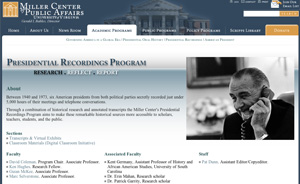talking history | syllabi | students | teachers | puzzle | about us
Presidential Recordings Program
http://millercenter.org/academic/presidentialrecordings
Created and maintained by the Miller Center of Public Affairs, University of Virginia, Charlottesville.
Reviewed Sept.-Nov. 2006.
In 1998 the Miller Center of Public Affairs of the University of Virginia began its Presidential Recordings Program, an effort to transcribe and annotate the five thousand hours of tape recordings made by presidents from Franklin D. Roosevelt through Richard M. Nixon. Led by the esteemed historian Timothy Naftali (who recently left to run the Richard Nixon Presidential Library, as that once-private institution becomes an official National Archives-run presidential library), a team of knowledgeable scholars has used state-of-the-art equipment and software to decipher and explain the discussions, arguments, gossip, maunderings, rantings, and ravings of our chief executives. W.W. Norton has already published collections of the John F. Kennedy and Lyndon B. Johnson transcripts, along with subject-specific studies of the Cuban missile crisis and the civil rights movement. More are expected.

Some of those books—particularly the Cuban missile crisis records, by Ernest May and Philip Zelikow, which were done independently of the Miller Center but are now part of its collection—have drawn fire for their errors. Needless to say, given the poor sound quality, background noise, and overlapping talk on many tapes, some mistakes are inevitable. And yet a project such as this must be able to claim a critical level of accuracy. For several years antagonists have jousted over the significance of the errors. Do they distort the meanings of conversations? Or are they mere nuances?
Readers can study the exchanges in this controversy to decide for themselves, and scholars using the tapes in their research should at any rate hear the actual recordings. But the debate over fidelity matters to everyone because it underscores the fallacy of regarding recordings as a source like no other. It is tempting to consider the White House tapes a unique primary source that affords, as documents do not, a rare, unmediated glimpse of history—the Rankean holy grail of the past “as it really was.” But the tapes are not a pellucid window onto history—just a new, valuable, fascinating resource.
Perhaps in response to the criticisms, the Presidential Recordings Program revamped its Web site. Aesthetically attractive, cleanly presented, and jam-packed with delicious information, the site is a terrific starting point for scholars seeking to use these texts in research or for voyeurs wishing to eavesdrop on the Oval Office. The site contains only a fraction of the program’s material—new conversations are posted under a heading called “updates”—but in forty-eight cases (so far) the raw transcripts are augmented by a clever, user-friendly mode of presentation, designed by David Coleman. As the recording plays on your computer, the words being spoken are highlighted in yellow, phrase by phrase, making them easy to follow. Seven other “virtual exhibits” delve more deeply into such issues as the 1965 civil rights protests at Selma and the space race, providing extensive, thoughtful commentary alongside the transcripts and audio snippets.
Beyond those featured recordings, the site contains scores of other audio files. Unfortunately, they are harder to find, and they lack titles, transcripts, and annotation. Though they are valuable as raw data and will save researchers a trip to Boston or Austin, one hopes that they too will be converted into the nifty multimedia presentations that will delight any visitor to the Presidential Recordings Program.
David Greenberg
Rutgers University
New Brunswick, New Jersey
